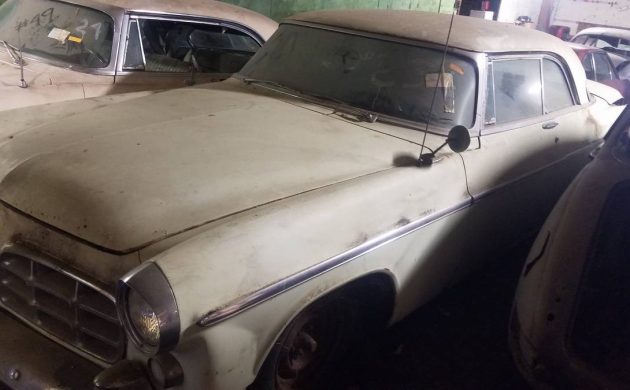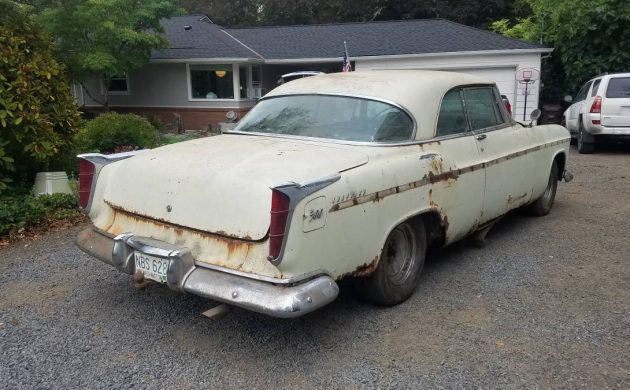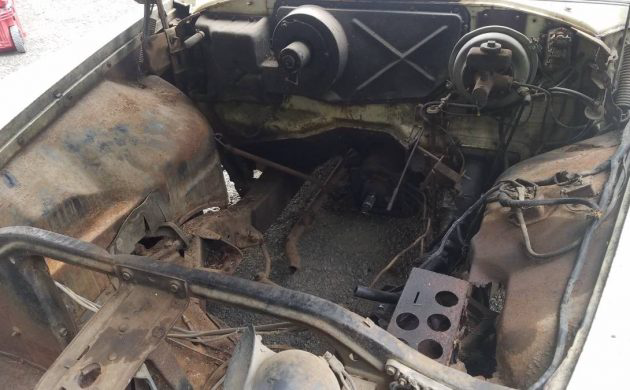Many consider the C-300 to be the first true muscle car. With its roots in NASCAR, Chrysler built 1,725 copies for street consumption. The name came from the 300 horses that the car’s 331 cubic-inch Hemi V8 produced. The C-300 would lead to the Chrysler C-Series cars that would be part of the company’s line-up well into the 1960s. This example has some rust and a missing engine but is likely worth restoring due to its rarity. Located in Hillsboro, Oregon, the 300 is available here on craigslist for $3,995. Hats off to Matt H. for the tip on this one!
Chrysler C-Series started using sequential lettering in 1956, changed annually from 300B, 300C, etc. The C-300 is sometimes referred to retroactively as the 300A. Its Hemi engine got its moniker from the hemispheric shape of the combustion chambers and was fitted with twin 4-barrel carburetors, a race-profiled camshaft setup, and solid valve lifters. The motor was exclusive to the 300, New Yorker, and Imperial Newport, but the 300 got a stiffer suspension and a performance exhaust.
The C-300 was put together from the Chrysler parts bin as the front clip, including the grille, was borrowed from the ’55 Imperial while the midsection came from a New Yorker hardtop. Then a Windsor rear quarter was appropriated to round out the package. Buyers had their choice of just three exterior colors: red, white, or black, flanked by a tan leather interior. When competing on the NASCAR circuit, the C-300 was labeled as the “world’s fastest stock car”.
We’re not privy to the history of the seller’s car, but it’s a roller at this stage as the Hemi V8 has flown the coop. There is rust present in most of the car’s sheet metal, but it doesn’t look terminal. The car is said to be complete and some of the trim pieces shown in one of the photos now appear to reside in the interior of the Chrysler. It looks to have been part of a ‘50s Mopar collection. These autos can command six figures when in desirable condition, but potential buyers should inquire about the lien that the seller says still hangs over the title.






As beaten by Doc Hudson at Thomasville Speedway in “Cars 3”.
Tread very carefully here…the nature of the lien may make you wish you hadn’t tried to buy this car!
It’s a crime to let a car of this significance degrade to this state. Now just a parts car. My dad bought a 55 New Yorker Deluxe St Regis brand new, which was virtually the same car as the 300 but with a different intake manifold and only one 4 barrel carb. I learned how to drive on that car, and it was fast for its time. Always saddened that he sold it in the late 60’s. But he had no place to store it and didn’t want to see it rot like this one.
As rare as this first-year `55 300 is, it will never have the full value as if it still had it’s original engine. All anyone can do at this point is perhaps drop in another 331 Hemi from a regular `55 New Yorker, and build it a bit if you can. Chances are nil of locating another `55 300 to rob the engine out of. This car would be (easily!) $120K to restore; if not more.
I always quite liked these, as they weren’t as big as some U.S. cars. They reminded me of Vlolvo 122s as well.
My earliest memory of my father’s cars was the same year and color scheme as this one (pictured) but a four door.
Wow, that is a great car!
Liens? Pass.
Well, “the 1st muscle car” will be debated until the end of time,,,our time, anyway. Many a bar fight originated from discussions on what was the “1st muscle car”,,for the public anyway. Some claim the supercharged Grahams of the 30’s were the 1st, others say the ’57 Rambler Rebel, and of course, the ’64 GTO has the biggest honor. Nothing was mentioned about a man named Carl Kiekhaefer, founder of Mercury Marine. In ’55-’56, he took several, hemi powered Chrysler 300’s like this, with “slight modifications” from his boat engine wizards, and with drivers like Tim Flock and Buck Baker, the best at the time, ( Carl paid them plenty, I read) and cleaned up on everyone. In ’57, NASCAR officials accused Carl of unfair modifications, and he told them all “to pound sand”, and withdrew his cars, and focused on Mercury Marine. He was a character.
While a nice car and restored, will turn heads while giving the driver a sweet ride, it still had “50’s styling” and I feel the ’55 Packard was a much nicer car.
And speaking of Carl Kiekhaefer, founder of Mercury Marine, lets not forget the incredible outboard motors this man was responsible for. Nothing sounds like one of those early “Tower of Power” black beauties that graced the back of many speedboats in the 60s.
@Howard A is right… I was THERE at the time… Big engines and the early Detroit Horsepower Race in HEAVY cars, has nothing to do with Muscle Cars.
The Detroit Iron,and Lead Sleds were replaced by MUSCLE in ’64 , and the Era was born
( Horsepower was not the criteria for beginning the Muscle Car Era….Detroit made some cars with potent horsepower for decades before the 300C . The Era began when horsepower was stuffed in to a car along with other performance Options as Standard Equipment , and the GTO concept was born.)
Lest people forget, the original GTO WAS AN OPTION on the Tempest LeMans.
Sorry, but the first American muscle car award goes to Studebaker. Yes, an independent car company who had Belt-driven Paxton superchargers, with pressurized 4 barrel carbs in their R2 motors, available in EVERY Studebaker car, even wagons.
Then there was the 1963/64 Studebaker Avanti, those could be had with the R3 engine, with increased engine size to 304.5, again with Paxton blower and pressurized 4 barrel carb. Or the rare R4, with dual 4 barrel carbs.
Andy Granatelli ran Studebaker Avanti cars at Bonneville, and set numerous land speed records that remained in place for decades.
Plus, these cars were available with Girling front disc brakes and Prestolite alternators. All this starting in 1963.
Backing up a bit, Studebaker crammed the Packard 320 V8 engine into the 1956 Golden Hawk. And then in 1957-58, since the Packard engine was no longer available, Studebaker installed a McCulloch belt-driven supercharger onto the Studebaker 289 V8. All 3 years had engine ratings of 275hp.
And of course Ford was offering the dual carb & supercharged T-birds in 1957.
Back in the late 1960s, while in high school, I had Supercharged Studebakers that I ran up against early GTOs, Mustangs, Camaros, etc. My Studie cars did very well.
I’m no expert on this model but I think it came with 354 Hemi dual quads. The original air cleaner will set you back a lot of greenbacks!
Close. The 55 came with a 331 hemi with dual quads. In 56 they came with a 354 hemi. In 57 and 58 they had the 392 hem’s.
Nice looking car. This has always been my favourite year for the Chrysler 300, at least until the 1965 Chrysler 300. Assuming all parts are available, all the rust is merely surface rust, and an engine can be found, I would imagine this would make an awesome project for a Mopar enthusiast.
The key to this car is the engine. Which is gone. This is a dead horse. The lien is the last shot. Parts car.
Without the original motor and a lien on the title , this car is not worth the AP
that is for cars of this stature with the matching numbers drive train ~
The cost to restore the car far exceeds its value as a roller and the lien on the title is worrisome as it appears this will make a great parts car for someone who already has a C-300 they already have ~ Sad to see a once great Mopar left to rot this way
Maybe a Hellcat drivetrain?